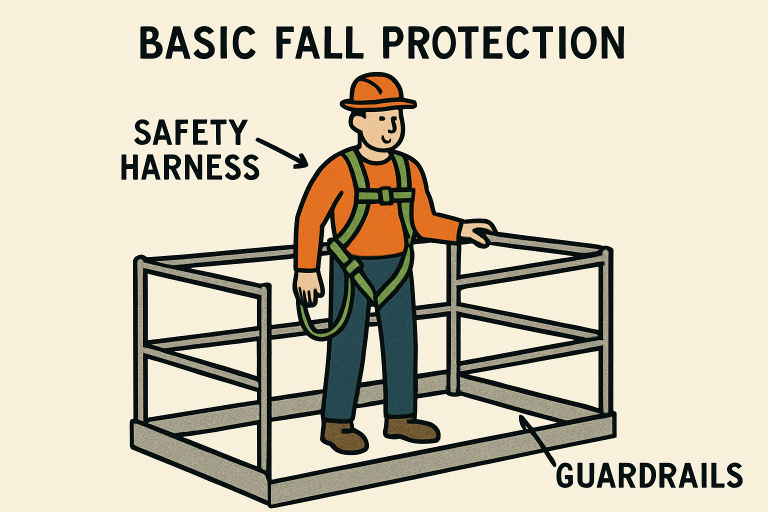Table of Contents
Understanding the Prevalence of Workplace Falls
Falls remain among the most significant risks facing workers in industries such as construction, manufacturing, warehousing, and utilities. The consequences are not limited to physical injury; they also affect productivity, worker morale, and organizational costs. Recognizing the danger, employers must prioritize fall-damage mitigation strategies and ensure the appropriate safety solutions are readily accessible. Companies seeking region-specific products can explore fall protection equipment Tulsa to meet local regulatory and operational needs.
The statistics from the Bureau of Labor Statistics paint a stark picture: 865 people lost their lives due to slips, trips, and falls, with the majority attributed to falls from height to a lower level. Such data illuminates the profound impact of preventable incidents and underscores why fall prevention must be the cornerstone of occupational safety initiatives. The financial ramifications are also immense, as fall-related incidents are among the most expensive workplace injuries, often resulting in long-term compensation claims and litigation.
Workplace falls can happen to anyone, regardless of experience level. Common causes include inadequate guardrails, slippery or cluttered surfaces, malfunctioning equipment, and insufficient safety training. Addressing root causes is critical to safeguard workers and protect businesses from legal and financial repercussions.
In many industries, efforts to reduce falls have been linked directly to long-standing safety campaigns and regulatory oversight. For employers, this means treating fall protection as a continuous priority and regularly evaluating hazards.
Implementing Effective Fall Protection Measures
Mitigating fall risks requires a systematic, layered approach combining engineering controls, administrative actions, and personal protective equipment (PPE). The first step is a comprehensive risk assessment that maps out all potential hazards specific to a job site or process. Investing time in site-specific hazard identification allows safety teams to proactively address weak points and incorporate preventative solutions into daily workflows.
- Risk Assessments: Regular evaluations are critical. This means scrutinizing workspaces for unguarded edges, uneven surfaces, unprotected openings, or improper use of ladders and scaffolds.
- Engineering Controls: Physical safety solutions such as guardrails, safety nets, and handrails provide passive protection. They are particularly important in high-traffic and elevated workspaces where the risk of a fall is constant.
- Personal Protective Equipment (PPE): Outfitting workers with harnesses, lanyards, self-retracting lifelines, and anchor points is crucial. Each component must be inspected routinely, as worn or damaged gear can fail when it’s needed most.
- Training and Education: Empower employees with the knowledge they need. Frequent safety training sessions help workers recognize, report, and mitigate hazards in real-time. Safety cultures thrive when workers understand their safety rights and responsibilities.
When national safety campaigns, like OSHA’s National Safety Stand-Down, celebrate proactive training and community involvement, organizations should take note and participate. Werner’s commitment to safety, as demonstrated by offering over 750 trainings in May 2025, serves as a model for other businesses. This approach combines hands-on instruction, virtual learning, and on-demand resources to reinforce key lessons.

Leveraging Technology for Enhanced Safety
Recent technological breakthroughs offer tools that can dramatically improve real-time detection and response to fall incidents. One of the most promising innovations is the use of wearable devices equipped with accelerometers that can detect falls from sudden changes in motion. When a fall is detected, these systems automatically alert supervisors or emergency responders—reducing response times and improving outcomes for injured workers. A recent study highlighted the high reliability and usefulness of accelerometer-based fall detection in industrial environments.
Other smart safety gear includes helmets with impact sensors, hazard detection beacons, and communication-enabled safety vests. Drones and AI-assisted site monitoring further extend an employer’s reach, providing real-time video analytics to assess risks in hard-to-monitor areas. Technology is not a substitute for traditional safety protocols; rather, it serves as a powerful complement, offering an additional layer of vigilance throughout the workday.
Success Stories: Technology Transforming Safety
Major companies are already seeing the benefits of integrating tech-based solutions into their safety programs. Johns Hopkins Medicine, for instance, adopted predictive analytics to identify and intervene with high-risk fall patients, resulting in measurable declines in patient falls.
Ensuring Compliance with Safety Regulations
Compliance is the foundation of effective fall protection. Every employer must stay current with Occupational Safety and Health Administration (OSHA) guidelines, industry consensus standards, and state-specific regulations. Unfortunately, OSHA’s annual reports repeatedly note that fall protection is its most frequently cited workplace violation, with 2025 marking the fifteenth consecutive year at the top.
Beyond avoiding costly citations, regulatory compliance helps foster trust among workers, customers, and business partners. In addition to federal rules, employers should monitor local and industry-specific codes that may have stricter requirements or supplemental standards.
Fostering a Culture of Accountability
Building a culture of safety starts with leadership. Managers who prioritize compliance, participate in safety audits, and encourage transparent reporting help establish a consistent tone throughout the organization. This includes providing up-to-date safety manuals, posting regulations in visible areas, and incentivizing staff to participate in safety programs.
Conclusion
Preventing workplace falls requires an integrated strategy that encompasses hazard assessments, effective engineering controls, the use of personal protective equipment, active employee training, and ongoing regulatory compliance. By embracing technological innovation and fostering a culture of safety accountability, employers can drastically reduce fall risks and protect their most valuable asset: their workforce. The result is not only fewer injuries and fatalities, but also a stronger and more resilient organization.
